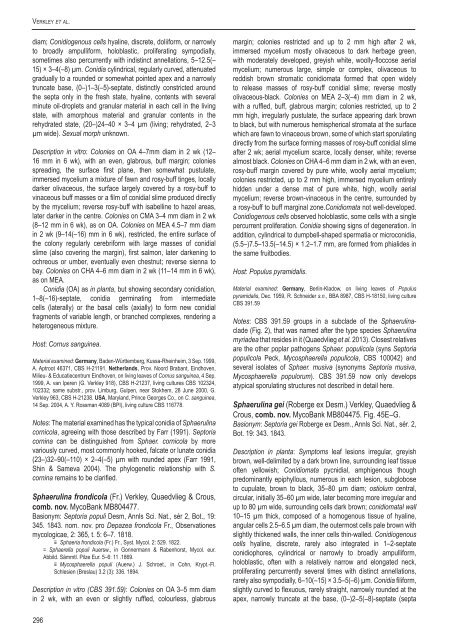A new approach to species delimitation in Septoria - CBS - KNAW
A new approach to species delimitation in Septoria - CBS - KNAW
A new approach to species delimitation in Septoria - CBS - KNAW
You also want an ePaper? Increase the reach of your titles
YUMPU automatically turns print PDFs into web optimized ePapers that Google loves.
Verkley et al.diam; Conidiogenous cells hyal<strong>in</strong>e, discrete, doliiform, or narrowly<strong>to</strong> broadly ampulliform, holoblastic, proliferat<strong>in</strong>g sympodially,sometimes also percurrently with <strong>in</strong>dist<strong>in</strong>ct annellations, 5–12.5(–15) × 3–4(–8) µm. Conidia cyl<strong>in</strong>drical, regularly curved, attenuatedgradually <strong>to</strong> a rounded or somewhat po<strong>in</strong>ted apex and a narrowlytruncate base, (0–)1–3(–5)-septate, dist<strong>in</strong>ctly constricted aroundthe septa only <strong>in</strong> the fresh state, hyal<strong>in</strong>e, contents with severalm<strong>in</strong>ute oil-droplets and granular material <strong>in</strong> each cell <strong>in</strong> the liv<strong>in</strong>gstate, with amorphous material and granular contents <strong>in</strong> therehydrated state, (20–)24–40 × 3–4 µm (liv<strong>in</strong>g; rehydrated, 2–3µm wide). Sexual morph unknown.Description <strong>in</strong> vitro: Colonies on OA 4–7mm diam <strong>in</strong> 2 wk (12–16 mm <strong>in</strong> 6 wk), with an even, glabrous, buff marg<strong>in</strong>; coloniesspread<strong>in</strong>g, the surface first plane, then somewhat pustulate,immersed mycelium a mixture of fawn and rosy-buff t<strong>in</strong>ges, locallydarker olivaceous, the surface largely covered by a rosy-buff <strong>to</strong>v<strong>in</strong>aceous buff masses or a film of conidial slime produced directlyby the mycelium; reverse rosy-buff with isabell<strong>in</strong>e <strong>to</strong> hazel areas,later darker <strong>in</strong> the centre. Colonies on CMA 3–4 mm diam <strong>in</strong> 2 wk(8–12 mm <strong>in</strong> 6 wk), as on OA. Colonies on MEA 4.5–7 mm diam<strong>in</strong> 2 wk (9–14(–16) mm <strong>in</strong> 6 wk), restricted, the entire surface ofthe colony regularly cerebriform with large masses of conidialslime (also cover<strong>in</strong>g the marg<strong>in</strong>), first salmon, later darken<strong>in</strong>g <strong>to</strong>ochreous or umber, eventually even chestnut; reverse sienna <strong>to</strong>bay. Colonies on CHA 4–6 mm diam <strong>in</strong> 2 wk (11–14 mm <strong>in</strong> 6 wk),as on MEA.Conidia (OA) as <strong>in</strong> planta, but show<strong>in</strong>g secondary conidiation,1–8(–16)-septate, conidia germ<strong>in</strong>at<strong>in</strong>g from <strong>in</strong>termediatecells (laterally) or the basal cells (axially) <strong>to</strong> form <strong>new</strong> conidialfragments of variable length, or branched complexes, render<strong>in</strong>g aheterogeneous mixture.Host: Cornus sangu<strong>in</strong>ea.Material exam<strong>in</strong>ed: Germany, Baden-Württemberg, Kussa-Rhe<strong>in</strong>heim, 3 Sep. 1999,A. Aptroot 46371, <strong>CBS</strong> H-21191. Netherlands, Prov. Noord Brabant, E<strong>in</strong>dhoven,Milieu- & Educatiecentrum E<strong>in</strong>dhoven, on liv<strong>in</strong>g leaves of Cornus sangu<strong>in</strong>ea, 4 Sep.1999, A. van Iperen (G. Verkley 918), <strong>CBS</strong> H-21237, liv<strong>in</strong>g cultures <strong>CBS</strong> 102324,102332; same substr., prov. Limburg, Gulpen, near S<strong>to</strong>khem, 28 June 2000, G.Verkley 963, <strong>CBS</strong> H-21238. USA, Maryland, Pr<strong>in</strong>ce Georges Co., on C. sangu<strong>in</strong>ea,14 Sep. 2004, A. Y. Rossman 4089 (BPI), liv<strong>in</strong>g culture <strong>CBS</strong> 116778.Notes: The material exam<strong>in</strong>ed has the typical conidia of Sphaerul<strong>in</strong>acornicola, agree<strong>in</strong>g with those described by Farr (1991). Sep<strong>to</strong>riacorn<strong>in</strong>a can be dist<strong>in</strong>guished from Sphaer. cornicola by morevariously curved, most commonly hooked, falcate or lunate conidia(23–)32–90(–110) × 2–4(–5) µm with rounded apex (Farr 1991,Sh<strong>in</strong> & Sameva 2004). The phylogenetic relationship with S.corn<strong>in</strong>a rema<strong>in</strong>s <strong>to</strong> be clarified.Sphaerul<strong>in</strong>a frondicola (Fr.) Verkley, Quaedvlieg & Crous,comb. nov. MycoBank MB804477.Basionym: Sep<strong>to</strong>ria populi Desm, Annls Sci. Nat., sér 2, Bot., 19:345. 1843. nom. nov. pro Depazea frondicola Fr., Observationesmycologicae, 2: 365, t. 5: 6–7. 1818.≡ Sphaeria frondicola (Fr.) Fr., Syst. Mycol. 2: 529. 1822.= Sphaerella populi Auersw., <strong>in</strong> Gonnermann & Rabenhorst, Mycol. eur.Abbild. Sämmtl. Pilze Eur. 5–6: 11 .1869.≡ Mycosphaerella populi (Auerw.) J. Schroet., <strong>in</strong> Cohn, Krypt.-Fl.Schlesien (Breslau) 3.2 (3): 336. 1894.Description <strong>in</strong> vitro (<strong>CBS</strong> 391.59): Colonies on OA 3–5 mm diam<strong>in</strong> 2 wk, with an even or slightly ruffled, colourless, glabrousmarg<strong>in</strong>; colonies restricted and up <strong>to</strong> 2 mm high after 2 wk,immersed mycelium mostly olivaceous <strong>to</strong> dark herbage green,with moderately developed, greyish white, woolly-floccose aerialmycelium; numerous large, simple or complex, olivaceous <strong>to</strong>reddish brown stromatic conidiomata formed that open widely<strong>to</strong> release masses of rosy-buff conidial slime; reverse mostlyolivaceous-black. Colonies on MEA 2–3(–4) mm diam <strong>in</strong> 2 wk,with a ruffled, buff, glabrous marg<strong>in</strong>; colonies restricted, up <strong>to</strong> 2mm high, irregularly pustulate, the surface appear<strong>in</strong>g dark brown<strong>to</strong> black, but with numerous hemispherical stromata at the surfacewhich are fawn <strong>to</strong> v<strong>in</strong>aceous brown, some of which start sporulat<strong>in</strong>gdirectly from the surface form<strong>in</strong>g masses of rosy-buff conidial slimeafter 2 wk; aerial mycelium scarce, locally denser, white; reversealmost black. Colonies on CHA 4–6 mm diam <strong>in</strong> 2 wk, with an even,rosy-buff marg<strong>in</strong> covered by pure white, woolly aerial mycelium;colonies restricted, up <strong>to</strong> 2 mm high, immersed mycelium entirelyhidden under a dense mat of pure white, high, woolly aerialmycelium; reverse brown-v<strong>in</strong>aceous <strong>in</strong> the centre, surrounded bya rosy-buff <strong>to</strong> buff marg<strong>in</strong>al zone.Conidiomata not well-developed.Conidiogenous cells observed holoblastic, some cells with a s<strong>in</strong>glepercurrent proliferation. Conidia show<strong>in</strong>g signs of degeneration. Inaddition, cyl<strong>in</strong>drical <strong>to</strong> dumpbell-shaped spermatia or microconidia,(5.5–)7.5–13.5(–14.5) × 1.2–1.7 mm, are formed from phialides <strong>in</strong>the same fruitbodies.Host: Populus pyramidalis.Material exam<strong>in</strong>ed: Germany, Berl<strong>in</strong>-Kladow, on liv<strong>in</strong>g leaves of Populuspyramidalis, Dec. 1959, R. Schneider s.n., BBA 8987, <strong>CBS</strong> H-18150, liv<strong>in</strong>g culture<strong>CBS</strong> 391.59Notes: <strong>CBS</strong> 391.59 groups <strong>in</strong> a subclade of the Sphaerul<strong>in</strong>aclade(Fig. 2), that was named after the type <strong>species</strong> Sphaerul<strong>in</strong>amyriadea that resides <strong>in</strong> it (Quaedvlieg et al. 2013). Closest relativesare the other poplar pathogens Sphaer. populicola (syns Sep<strong>to</strong>riapopulicola Peck, Mycosphaerella populicola, <strong>CBS</strong> 100042) andseveral isolates of Sphaer. musiva (synonyms Sep<strong>to</strong>ria musiva,Mycosphaerella populorum). <strong>CBS</strong> 391.59 now only developsatypical sporulat<strong>in</strong>g structures not described <strong>in</strong> detail here.Sphaerul<strong>in</strong>a gei (Roberge ex Desm.) Verkley, Quaedvlieg &Crous, comb. nov. MycoBank MB804475. Fig. 45E–G.Basionym: Sep<strong>to</strong>ria gei Roberge ex Desm., Annls Sci. Nat., sér. 2,Bot. 19: 343. 1843.Description <strong>in</strong> planta: Symp<strong>to</strong>ms leaf lesions irregular, greyishbrown, well-delimited by a dark brown l<strong>in</strong>e, surround<strong>in</strong>g leaf tissueoften yellowish; Conidiomata pycnidial, amphigenous thoughpredom<strong>in</strong>antly epiphyllous, numerous <strong>in</strong> each lesion, subglobose<strong>to</strong> cupulate, brown <strong>to</strong> black, 35–80 µm diam; ostiolum central,circular, <strong>in</strong>itially 35–60 µm wide, later becom<strong>in</strong>g more irregular andup <strong>to</strong> 80 µm wide, surround<strong>in</strong>g cells dark brown; conidiomatal wall10–15 µm thick, composed of a homogenous tissue of hyal<strong>in</strong>e,angular cells 2.5–6.5 µm diam, the outermost cells pale brown withslightly thickened walls, the <strong>in</strong>ner cells th<strong>in</strong>-walled. Conidiogenouscells hyal<strong>in</strong>e, discrete, rarely also <strong>in</strong>tegrated <strong>in</strong> 1–2-septateconidiophores, cyl<strong>in</strong>drical or narrowly <strong>to</strong> broadly ampulliform,holoblastic, often with a relatively narrow and elongated neck,proliferat<strong>in</strong>g percurrently several times with dist<strong>in</strong>ct annellations,rarely also sympodially, 6–10(–15) × 3.5–5(–6) µm. Conidia filiform,slightly curved <strong>to</strong> flexuous, rarely straight, narrowly rounded at theapex, narrowly truncate at the base, (0–)2–5(–8)-septate (septa296
















